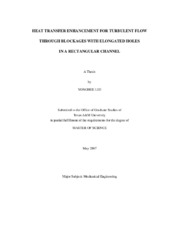| dc.description.abstract | In this thesis, turbulent forced convective heat transfer downstream of blockages
with elongated holes in a rectangular channel was studied.
The rectangular channel has a width-to-height ratio of 12:1. The blockages have
the same cross section as that of the channel. The diameter of all elongated holes of the
blockages is three quarters of the channel height. The blockages are classified into two
different types with two different hole-to-blockage area ratios (ratio of total crosssectional
area of holes to cross-sectional surface area of the blockage) of 0.5 or 0.6. For
each hole-to-blockage area ratio, the blockages are again subdivided into three different
cases using three different aspect ratios (hole-width-to-height ratio) which are
determined by the number of holes four, six, and eight holes per blockage.
Experiments for total six different cases of blockages were performed under a uniform
wall temperature condition (50C). The experiments were conducted at three different
Reynolds numbers of about 7,000, 12,000, and 17,000, respectively. Three copper plate
heaters with twenty one embedded thermocouples were used to measure the average heat
transfer on the surface of channel walls between two consecutive blockages.
Results from this study showed that the blockages with elongated holes enhance
the average heat transfer by up to 5.06 and 4.08 times that by fully developed turbulent
flow through a smooth channel at the same Reynolds numbers for small and large holeto-
blockage area ratios, respectively. The friction factor ratios for small and large holeto-
blockage area ratios of the blockages reached 345 and 89 times, respectively, that by
fully developed turbulent flow through a smooth channel at the same Reynolds numbers.
TP (Thermal Performance) values varied from 0.65 to 1.11 depending on cases.
According to the results, Case L-2, which has six elongated holes and hole-toblockage
area ratio of 0.6, is the best option from the TP point of view. But Case S-2,
which also had six elongated holes and hole-to-blockage area ratio of 0.5, can be an
alternative when more weight should be put on the heat transfer enhancement than TP
value. | en |


